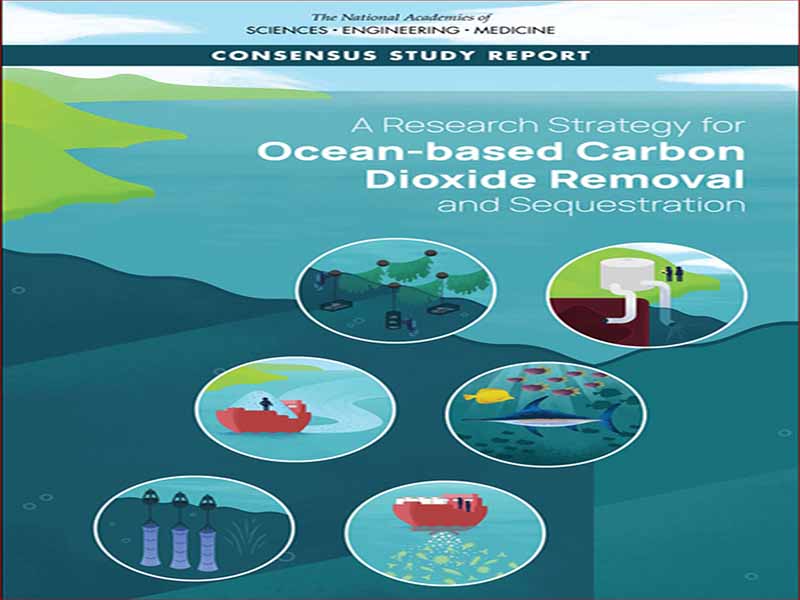- عنوان کتاب: A Research Strategy for Ocean based Carbon Dioxide Removal and Sequestration
- نویسنده: Scott Doney
- حوزه: دی اکسید کربن
- سال انتشار: 2022
- تعداد صفحه: 1379
- زبان اصلی: انگلیسی
- نوع فایل: pdf
- حجم فایل: 14.2 مگابایت
در طول چند صد سال گذشته، افزایش مصرف سوختهای فسیلی در جامعه و تغییر گسترده بیوسفر زمینی منجر به افزایش چشمگیر سطوح دیاکسید کربن (CO2) و سایر گازهای گلخانهای در اتمسفر شده است. تغییرات آب و هوایی جهانی ناشی از آن یکی از مبرم ترین مسائلی است که جامعه امروز با آن مواجه است. کاهش انتشار CO2 انسانی به ویژه چالش برانگیز است زیرا استفاده از سوخت فسیلی به طور گسترده در سیستم انرژی و اقتصاد مدرن ما تعبیه شده است. بنابراین، شبکه گسترده ای در حال جستجو برای مجموعه ای از راه حل ها برای کربن زدایی اقتصاد و شاید حتی حذف فعال و جداسازی ایمن CO2 از جو است. بیش از نیم قرن پیش، Revelle و Suess1 یک مطالعه پیشگام در مورد نقش اقیانوس در حذف CO2 اضافی از اتمسفر به دلیل انتشارات انسانی نوشتند. مقاله آنها در زمانی منتشر شد که اطلاعات علمی کاملاً محدودی در مورد سیستم کربن اقیانوس وجود داشت. این تنها چند ماه قبل از شروع سری زمانی نمادین CO2 جو توسط دیوید کیلینگ در سال 1957 در Mauna Loa، هاوایی منتشر شد که یکی از قویترین محدودیتها را در مورد سرنوشت انتشار CO2 انسانی ارائه میکند. بر اساس دهههای بعدی علم اقیانوس و تحقیقات چرخه کربن، تخمینهای مدرن به وضوح نشان میدهد که فرآیندهای طبیعی اقیانوسها برای حذف حدود یک چهارم انتشار CO2 انسانی ناشی از مصرف سوختهای فسیلی و جنگلزدایی از جو عمل میکنند. بنابراین، اقیانوس در حال حاضر خدمات ارزشمندی را ارائه می دهد که رشد CO2 اتمسفر و تغییرات آب و هوایی مرتبط را کاهش می دهد، هر چند به قیمت افزایش سطح اسیدی شدن اقیانوس ها. سرنوشت غالب درازمدت دیاکسید کربن اضافی ناشی از انتشارات انسانی این است که طی قرنها تا هزارهها به اقیانوسها ختم شود. این موضوع این سوال را مطرح میکند که آیا جامعه میتواند (و باید) برای تسریع فرآیندهای اقیانوسی که CO2 را از جو خارج و ذخیره میکند، تلاش کند. روشهای متعددی برای حذف عمدی دیاکسید کربن اقیانوس (CDR)، از روشهای بیولوژیکی و ژئوشیمیایی تا تکنیکهای صنعتی بیشتر، توسط دانشمندان، مهندسان و فنشناسان پیشنهاد شدهاند. همانطور که در بدنه این گزارش توضیح داده شد، سؤالات حل نشده حیاتی در مورد بسیاری از جنبه های CDR اقیانوس ها باقی مانده است، و این گزارش یک نمای کلی از وضعیت فعلی درک ما و یک مسیر تحقیقاتی احتمالی رو به جلو برای حل این شکاف های دانش بزرگ ارائه می دهد. این یک گزارش در مورد یک دستور کار تحقیقاتی برای اطلاع رسانی بهتر تصمیمات اجتماعی آینده در مورد CDR اقیانوس است. کمیته موافق یا علیه استقرار احتمالی CDR اقیانوس در آینده نیست، و کمیته تشخیص می دهد که CDR اقیانوس در بهترین حالت، نقش رویکردهای کاهش آب و هوا از جمله کربن زدایی را تکمیل می کند. این گزارش بر اساس مطالعات قبلی آکادمی های ملی علوم، مهندسی و پزشکی، به ویژه منطق و چارچوب برای تحقیقات در مورد CDR ارائه شده در گزارش 2015 در مورد مداخله آب و هوا: حذف دی اکسید کربن و جداسازی قابل اعتماد، استوار است. گزارش CDR اقیانوس در اینجا همچنین به تمرکز بیشتر زمینی گزارش 2019 در مورد فناوریهای انتشار منفی و ترسیب قابل اعتماد: یک دستور کار تحقیقاتی میافزاید. این گزارش از بسیاری از ارائههای روشنگرانه که توسط سخنرانان خارجی و شرکتکنندگان در جلسات عمومی و کارگاه آموزشی کمیته ارائه شد، بهره فراوان برد. به دلیل COVID-19، کار کمیته تحت شرایط غیرعادی جلسات فقط مجازی تکمیل شد، چالشی که با فاصله زمانی نسبتاً کوتاهی برای گزارش تشدید شد. میخواهم از اعضای کمیته و کارکنان آکادمیهای ملی به خاطر فداکاری، انرژی، و بحثهای متفکرانه و مشارکتهایشان در سال گذشته تشکر ویژه کنم.
Over the past several hundred years, society’s expanding consumption of fossil fuels and extensive alteration of the terrestrial biosphere has led to a dramatic rise in atmospheric levels of carbon dioxide (CO2) and other greenhouse gases. The resulting global climate change is one of the most pressing issues facing society today. Slowing human CO2 emissions is particularly challenging because fossil fuel use is embedded widely in our modern energy system and economy. Thus, a broad net is being cast searching for a portfolio of solutions to decarbonize the economy and perhaps even actively remove and safely sequester CO2 away from the atmosphere. More than a half century ago, Revelle and Suess1 wrote a pioneering study on the ocean’s role in removing from the atmosphere excess CO2 due to human emissions. Their paper was published at a time when there was quite limited scientific information on the ocean carbon system. It was published just months before the start of the iconic atmosphere CO2 time series by David Keeling in 1957 at Mauna Loa, Hawai’i, that provides one of the most robust constraints on the fate of human CO2 emissions. Based on decades of subsequent ocean science and carbon cycle research, modern estimates clearly indicate that natural ocean processes act to remove from the atmosphere about a quarter of human CO2 emissions from fossil fuel consumption and deforestation. Thus, the ocean already provides an invaluable service slowing the atmospheric growth of CO2 and associated climate change, though at the cost of rising levels of ocean acidification. The predominant long-term fate of excess CO2 from human emissions is to end up in the ocean over centuries to millennia. This raises the question of whether society could (and should) attempt to accelerate ocean processes that remove and store CO2 away from the atmosphere. Numerous approaches for deliberate ocean carbon dioxide removal (CDR), ranging across biological and geochemical methods to more industrial techniques, have been proposed by scientists, engineers, and technologists. As described in the body of this report, there remain crucial unresolved questions regarding many aspects of ocean CDR, and this report provides an overview of our current state of understanding and a possible research path forward to resolve these major knowledge gaps. This is a report on a research agenda to better inform future societal decisions on ocean CDR; the Committee is not advocating either for or against possible future ocean CDR deployments, and the Committee recognizes that ocean CDR would, at best, complement the role of climate mitigation approaches including decarbonization. This report builds heavily on previous National Academies of Sciences, Engineering, and Medicine studies, in particular the rationale and framing for research on CDR provided in the 2015 report on Climate Intervention: Carbon Dioxide Removal and Reliable Sequestration. The ocean CDR report here also adds to the more terrestrial focus of the 2019 report on Negative Emissions Technologies and Reliable Sequestration: A Research Agenda. The report benefited greatly from many insightful presentations given by external speakers and the participants at the Committee’s public meetings and workshop. Because of COVID-19, the Committee’s work was completed under the unusual conditions of virtual-only meetings, a challenge compounded by a relatively short time span for the report. I want to extend a special thanks to the Committee members and National Academies staff for their dedication, energy, and thoughtful discussion and contributions over the past year.
این کتاب را میتوانید از لینک زیر بصورت رایگان دانلود کنید:
Download: A Research Strategy for Ocean based Carbon Dioxide Removal and Sequestration




































نظرات کاربران